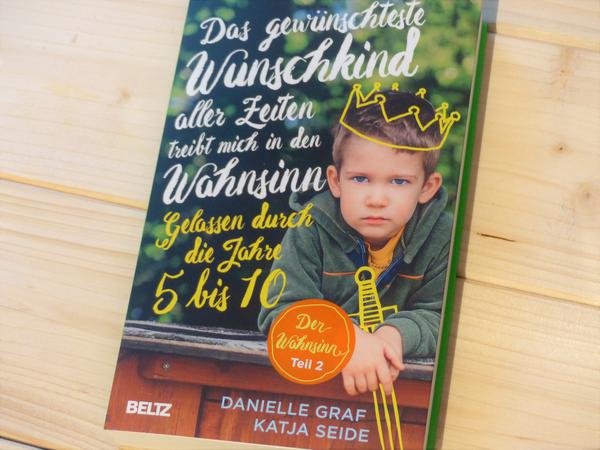≫The most desired wish child ever - Part 2≪
I had to abbreviate the title of the book in the headline because it is actually very long. The book title is: The most desired wish child of all time drives me crazy - Serene through the years 5 to 10 (The madness part 2). I just finished reading it and would like to introduce this book to you here.
General Information
The book was written by Danielle Graf and Katja Seide. On the blurb I can read that it would be the biggest German parenting blog by now. The book was published in the first edition in 2018 by Beltz Verlag. Price-wise, the book is 16,95€ at Amazon, the Kindle version costs 15,99€. It has 360 pages. The cover features a boy wearing a painted crown on his head and holding a painted sword in his hand.

The blurb promises that the book will provide answers to the most important questions about years 5 to 10, which present some challenges. It is about an upbringing far from punishment and reward, towards a life at eye level with empathy and the assumption of personal responsibility. In addition, personal accounts are to be found in the book.
The authors
Originally, the two authors, as already indicated, started with a blog with the same name (The most desired wish child ever drives me crazy), which has been around since 2013. On the blog page I can read that Katja Seide lives in Berlin with her family. Professionally, she works with children with behavioral problems as a special educator. She lets her professional experiences flow into the book again and again.
Danielle Graf, on the other hand, lives a bit more rural and works as a lawyer, as I can also read on the blog page.
The content
The book is divided into seven chapters, which are also divided into subchapters. There are example situations and possible areas of conflict that fit and how solutions and ways can be found.
First of all, it becomes clear that the phase between 5 and 10 years is often not so easy and that it is sometimes not so easy to master this "tightrope act". This period is also referred to by the authors as gap-tooth puberty. It becomes clear that with a relationship-orientated path we do not raise bullies, as is so often claimed.
It then goes on to explain that children of the age described are already very independent in many things, but in other areas they still rely heavily on adult help. It is about the difference between wants and needs and what this means for everyday life. It describes how solutions can be found when there are several incompatible needs.
This is followed by sections on how we can empower our children, but also where it makes sense to allow self-determination. It is about what it means to take personal responsibility and where it is important that we as parents take a step back so that our children can take it. Topics such as cell phones and media consumption are also addressed here.
Then it's about what we do instead of punishments and rewards. The authors show a way forward that is much more about empathy and respect. They make it clear how important it is to treat our children as equals. At the same time, it becomes clear at this point where the children's limits are or where they are still developing, which explains various behaviors.
The last chapters are much about communication. It is about understanding and accepting the content of what is said on different levels. It can be seen that there is often much more behind what we say than just the mere words. Further it is described how a suitable solution for all (family members) can be found out of a difficult situation.
My opinion
The book Das gewünschteste Wunschkind aller Zeiten treibt mich in den Wahnsinn - Gelassen durch die Jahre 5 bis 10 (Der Wahnsinn Teil 2) by Danielle Graf and Katja Seide describes many topics that I am already thinking about with my "only" 4-year-old son. So it can also be useful to read it earlier.
It has strengthened me in my dealings with my child and has shown me alternatives in some places that I would not have thought of. It has made clear to me how stuck I (and many others probably also) sometimes am in my thinking and thus do not recognize the most obvious solutions. I've started to question some "You can't do that!" and "You can't do that!" and see if maybe it can be done.
Overall, great food for thought in many important areas that affect this age group.
No comments yet.